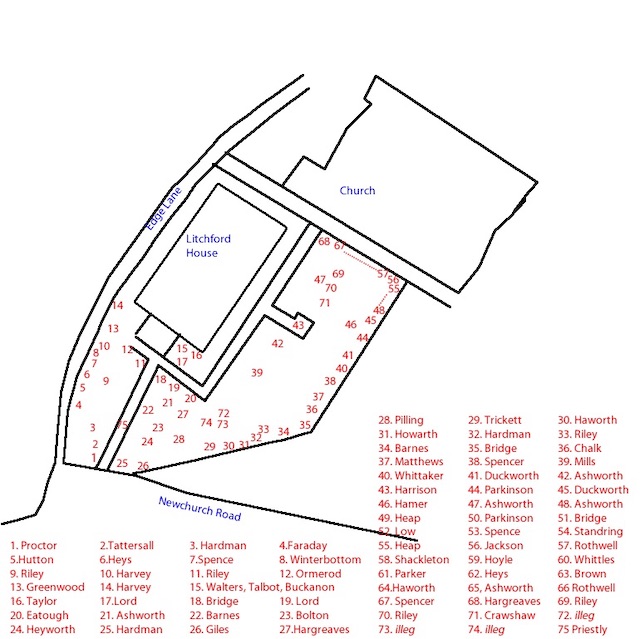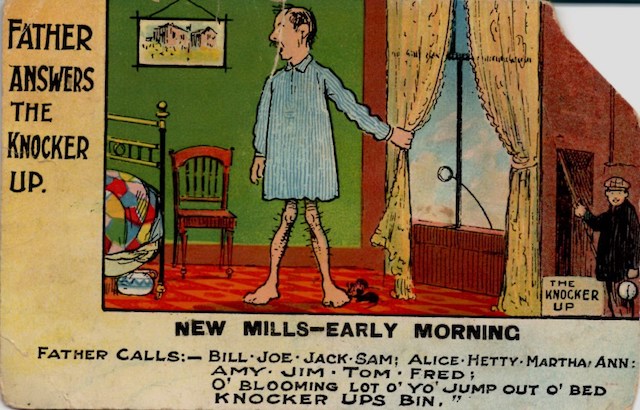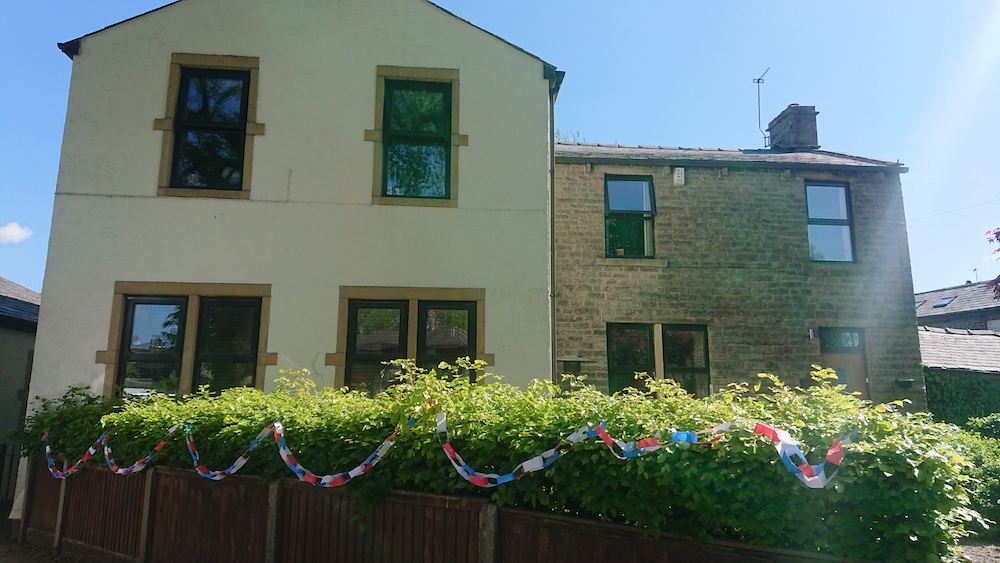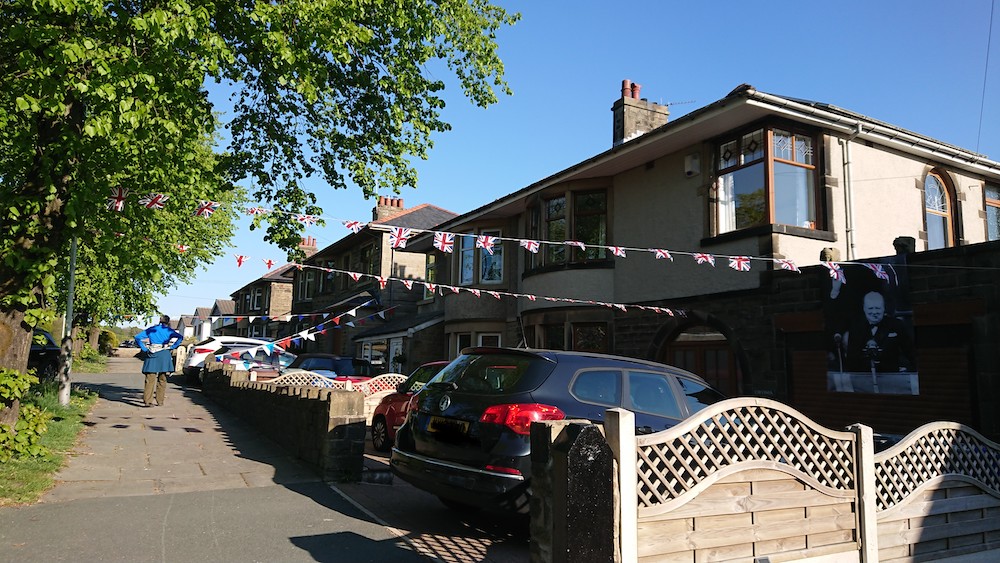May 2020
52 residents # 22 uncertain
31/05/20 22:53
Oh my goodness:
Where did Mary Ann Ashworth go to school? Her obituary states 'in Rochdale', but where?
Where was 'Ivy Cottage'? It's on the census but not on any map I've seen and the census is too vague to be certain.
Where are 'the portraits of [Charles Patrick] and his wife by Brodie' as mentioned in his will?
How was Betty Ashworth nee Ormerod related to the Ormerods of Ormerod, if at all?
Why did Charles Patrick come back from Canada and how did he end up as sub-inspector of factories in Rochdale?
Why were there two major C17 dissenting congregations within quarter of a mile of each other?
Did the Bridge family have the same farm for over 200 years and if so how can I prove it?
What information was lost when the gravestones were moved when Sion's old chapel was converted into flats?
How and why did John Ashworth move from wool manufacture to coal mining?
How did Charlotte Ann Hargreaves come to own the land on which Springhill stands?
Where exactly was the C16 pinfold? Allegedly in what is now the garden of Plantation House.
Which of the two 'Cross Cottages', approx 100 yards from each other, does any given document refer?
And, not connected with my Springhill study:
Who was my paternal gg grandfather?
How did my paternal gif get from Wiltshire to Rossendale and what was he doing between 1861 and 1891?
Where did Mary Ann Ashworth go to school? Her obituary states 'in Rochdale', but where?
Where was 'Ivy Cottage'? It's on the census but not on any map I've seen and the census is too vague to be certain.
Where are 'the portraits of [Charles Patrick] and his wife by Brodie' as mentioned in his will?
How was Betty Ashworth nee Ormerod related to the Ormerods of Ormerod, if at all?
Why did Charles Patrick come back from Canada and how did he end up as sub-inspector of factories in Rochdale?
Why were there two major C17 dissenting congregations within quarter of a mile of each other?
Did the Bridge family have the same farm for over 200 years and if so how can I prove it?
What information was lost when the gravestones were moved when Sion's old chapel was converted into flats?
How and why did John Ashworth move from wool manufacture to coal mining?
How did Charlotte Ann Hargreaves come to own the land on which Springhill stands?
Where exactly was the C16 pinfold? Allegedly in what is now the garden of Plantation House.
Which of the two 'Cross Cottages', approx 100 yards from each other, does any given document refer?
And, not connected with my Springhill study:
Who was my paternal gg grandfather?
How did my paternal gif get from Wiltshire to Rossendale and what was he doing between 1861 and 1891?
52 residents # 21 tombstone
23/05/20 22:48
A brief blog this week, and a graphic illustrating the layout of the remaining tombstones of Sion Baptist Church transcribed May 2014. Unfortunately many stones were lost and others moved when the old chapel was converted into flats in the early 1980s.
So many stories behind these stones, many feature in other pages of this site or entries in this blog. Others are still to be researched.

So many stories behind these stones, many feature in other pages of this site or entries in this blog. Others are still to be researched.

52 residents #20 travel
18/05/20 22:48
Well there's not much of that at the moment. Springhill residents, together with the rest of the world, are cancelling their summer holidays and hardly daring to make plans for later in the year. Meanwhile they are celebrating being able to drive to take their daily (or now, more than once daily) exercise.
In many ways though the residents of Springhill are lucky in having so many beautiful walks/cycle rides available directly from the front door. Many of these are feasible even in lockdown, though the 'tops' have been busier than usual as people take the opportunity to explore their local area and enjoy the good weather.
Some of these walks pass over Hurst Lane, one of the original C16 roads through Rossendale. Others go over Oakenheadwood Lane, another old route. Oakenheadwood is in reasonably good condition but Hurst Lane on the other hand. Whilst technically a road, and occasionally subject to 4x4 drivers' attempts to use it as such, it has probably changed little since the area emerged from Forest law in 1507.
There are a number of entries in the Clitheroe Court Rolls in the C16/17 where various residents were amerced for failing to maintain the highway. Others were cited for obstructing the highway, and the blocking of rights of way by landowners is still going on. Others were in trouble for trespassing with beasts. It isn't usually beasts but trail bikes (and occasionally horses) on the footpaths churning up the subsoil and causing damage which it the modern equivalent.
The Haslingden to Todmorden turnpike, of which Newchurch Road is part, was established in the later years of the C18 and extended up to Burnley in what is now Burnley Road (Rawtenstall), Burnley Road East and Burnley Road (Bacup) in and around 1915. Road namers had a lot of imagination in those days.
Canals passed us by but the coming of the railways meant that quarrying became economical. Trams ran along the main roads but not over Newchurch Road, probably because the gradient on Turnpike was too steep.
The roads gradually became more congested and the Edenfield bypass was constructed in the 1960s. The intention then was that any motorway extension would go up through Rawtenstall and Crawshawbooth to Burnley. Of course it didn't, but the M66 motorway extension cut travelling time to Manchester down by about an hour.
For most journeys however walking is fine!
In many ways though the residents of Springhill are lucky in having so many beautiful walks/cycle rides available directly from the front door. Many of these are feasible even in lockdown, though the 'tops' have been busier than usual as people take the opportunity to explore their local area and enjoy the good weather.
Some of these walks pass over Hurst Lane, one of the original C16 roads through Rossendale. Others go over Oakenheadwood Lane, another old route. Oakenheadwood is in reasonably good condition but Hurst Lane on the other hand. Whilst technically a road, and occasionally subject to 4x4 drivers' attempts to use it as such, it has probably changed little since the area emerged from Forest law in 1507.
There are a number of entries in the Clitheroe Court Rolls in the C16/17 where various residents were amerced for failing to maintain the highway. Others were cited for obstructing the highway, and the blocking of rights of way by landowners is still going on. Others were in trouble for trespassing with beasts. It isn't usually beasts but trail bikes (and occasionally horses) on the footpaths churning up the subsoil and causing damage which it the modern equivalent.
The Haslingden to Todmorden turnpike, of which Newchurch Road is part, was established in the later years of the C18 and extended up to Burnley in what is now Burnley Road (Rawtenstall), Burnley Road East and Burnley Road (Bacup) in and around 1915. Road namers had a lot of imagination in those days.
Canals passed us by but the coming of the railways meant that quarrying became economical. Trams ran along the main roads but not over Newchurch Road, probably because the gradient on Turnpike was too steep.
The roads gradually became more congested and the Edenfield bypass was constructed in the 1960s. The intention then was that any motorway extension would go up through Rawtenstall and Crawshawbooth to Burnley. Of course it didn't, but the M66 motorway extension cut travelling time to Manchester down by about an hour.
For most journeys however walking is fine!
the knocker upper
10/05/20 22:44
The knocker upper man (although it was not always a man) was a well known figure in Industrial Lancashire. Armed with a long pole he would walk the streets in the early morning and, for a small fee, bang the pole against the front upstairs window of the property to waken up the residents in time for work. Here a stylised video of a knocker upper in action in Burnley, from the NW film archives. This of course became the focus of a number of folk songs and not a few bawdry jokes ('he could do seven streets on a good night') and, on a more serious note, a ballad about cotton in industrial Rossendale by Mike Harding. With quite substantial fines for lateness and the mills starting at 6am, the knocker upper played a vital role in the pre-alarm clock days. It is said that the last knocker upper retired in Bolton in 1973.

However to the best of my knowledge knocker uppers were adults. I was surprised therefore to see in the 1871 census entry for Cloughfold:

A nine year old getter up?
A bit of detective work by @Dave_Lifelines 'Lifelines Research' indicated that she was indeed not a 'knocker upper' or even a 'getter upper' but a 'gaiter upper'. This quote from the 1927 Dictionary of Occupational Terms explains:

He was even kind enough to find me an example from a family approx 4 miles away in 1871:

However @CuriousDigger says he was aware of someone 3 miles or so in the other direction whose job as a child was to go to the pub (presumably in the morning!) to get the men up for work!
Now I know one of the perennial questions is 'who knocked up the knocker upper man?' (akin to 'how does the snow plough driver get to work?'). But that's for another day.
(with thanks to all who joined in the discussion).

However to the best of my knowledge knocker uppers were adults. I was surprised therefore to see in the 1871 census entry for Cloughfold:

A nine year old getter up?
A bit of detective work by @Dave_Lifelines 'Lifelines Research' indicated that she was indeed not a 'knocker upper' or even a 'getter upper' but a 'gaiter upper'. This quote from the 1927 Dictionary of Occupational Terms explains:

He was even kind enough to find me an example from a family approx 4 miles away in 1871:

However @CuriousDigger says he was aware of someone 3 miles or so in the other direction whose job as a child was to go to the pub (presumably in the morning!) to get the men up for work!
Now I know one of the perennial questions is 'who knocked up the knocker upper man?' (akin to 'how does the snow plough driver get to work?'). But that's for another day.
(with thanks to all who joined in the discussion).
52 residents # 19 service
08/05/20 22:39
It seems apposite that 'service' should be the blogging prompt on the 75th anniversary of VE day, marking the end of the second world war in Europe. To my shame I have not researched Springhill residents' involvement in the war - another item on my massive 'to do' list.
I do know that Springhill resident Jack Watkins was living about 2 miles away in Whitewell Bottom at the time. He was too young to serve but as a teenager was involved in fire watching. This involved keeping watch at night in case a stay bomb should land on the village (which at that time comprised approximately 200 people), then run to the public phone box to raise the alarm. He did wonder what to do should the bomb take out the telephone box. Unlike WW1 when a couple of strays did land close to Springhill (and thankfully did not ignite or explode), Jack was undisturbed during his nights of watching.
I also know of Nellie Redman, the sister of Springhill resident Alice Taylor nee Hargreaves who was brought before the magistrates for breaching the blackout. The magistrate, a rather severe lady with glasses well down her nose, stared and Nellie and asked how she pleaded. 'Oh guilty, guilty' was the reply. Nellie received a token fine. The magistrate, Carrie Whitehead, was a member of a well know local family and sister to a Springhill resident Harold Whitehead.
Of course this isn't 'service' as such but the war affected everybody in different ways, just as the current covid situation does today. Those of us on the 'front line' (and really, we are just doing our jobs) are supported by those who deliver to and staff the shops for example, and those whose social distancing during lockdown has helped prevent the NHS being swamped with cases.
Bunting in Springhill was a relatively subdued affair:

but this was approx 75 yards away on Newchurch Road. Note Churchill on the right.

I do know that Springhill resident Jack Watkins was living about 2 miles away in Whitewell Bottom at the time. He was too young to serve but as a teenager was involved in fire watching. This involved keeping watch at night in case a stay bomb should land on the village (which at that time comprised approximately 200 people), then run to the public phone box to raise the alarm. He did wonder what to do should the bomb take out the telephone box. Unlike WW1 when a couple of strays did land close to Springhill (and thankfully did not ignite or explode), Jack was undisturbed during his nights of watching.
I also know of Nellie Redman, the sister of Springhill resident Alice Taylor nee Hargreaves who was brought before the magistrates for breaching the blackout. The magistrate, a rather severe lady with glasses well down her nose, stared and Nellie and asked how she pleaded. 'Oh guilty, guilty' was the reply. Nellie received a token fine. The magistrate, Carrie Whitehead, was a member of a well know local family and sister to a Springhill resident Harold Whitehead.
Of course this isn't 'service' as such but the war affected everybody in different ways, just as the current covid situation does today. Those of us on the 'front line' (and really, we are just doing our jobs) are supported by those who deliver to and staff the shops for example, and those whose social distancing during lockdown has helped prevent the NHS being swamped with cases.
Bunting in Springhill was a relatively subdued affair:

but this was approx 75 yards away on Newchurch Road. Note Churchill on the right.

52 residents # 18 where there's a will
01/05/20 21:55
I've blogged before about the will of Mary Patrick nee Ashworth, the terms of which were still in dispute 25 years later.
I've also blogged about the will of Charles Patrick, and the codicil describing his wishes regarding the equitable distribution of the water on Saunder Height between his two beneficiaries.
I will go however with the will of Bathsheba Davenport, milliner, spinster, of Newchurch, d 4 Sept 1893. This has some fascinating clauses:
A legacy to the children of her nieces or nephews if any happen to be blind, for as long as they remain blind. If none be blind then to the blind people associated with a number of local churches specified in the document.
Pictures of Mr and Mrs Gladstone (with frames) to one great nephews.
Her underclothing, in equal shares, to her two nieces.
The will I want to track down however it that of Lettice Jackson who died in the mid C17, leaving land to the Rector of Newchurch.Oh how I want to know where that was.
I've also blogged about the will of Charles Patrick, and the codicil describing his wishes regarding the equitable distribution of the water on Saunder Height between his two beneficiaries.
I will go however with the will of Bathsheba Davenport, milliner, spinster, of Newchurch, d 4 Sept 1893. This has some fascinating clauses:
A legacy to the children of her nieces or nephews if any happen to be blind, for as long as they remain blind. If none be blind then to the blind people associated with a number of local churches specified in the document.
Pictures of Mr and Mrs Gladstone (with frames) to one great nephews.
Her underclothing, in equal shares, to her two nieces.
The will I want to track down however it that of Lettice Jackson who died in the mid C17, leaving land to the Rector of Newchurch.Oh how I want to know where that was.




